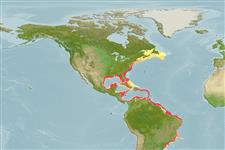Common names from other countries
Environment: milieu / climate zone / depth range / distribution range
Sinh thái học
; Mức độ sâu 0 - 130 m (Ref. 103830), usually ? - 30 m (Ref. 103558). Tropical; 73°N - 28°S, 98°W - 33°W
Western Atlantic and the Arctic: Bermuda, Nova Scotia, from Chesapeake Bay to Florida Keys, Gulf of Mexico, Caribbean Sea to Brazil up to Santa Catarina.
Length at first maturity / Bộ gần gũi / Khối lượng (Trọng lượng) / Age
Maturity: Lm ?, range 1 - ? cm Max length : 9.2 cm TL con đực/không giới tính; (Ref. 8); common length : 8.0 cm TL con đực/không giới tính; (Ref. 8)
Common total length: 6.0 to 8.0 cm (Ref. 8). This is an oceanic, demersal species found up to 130 meters in depth (Ref. 103831). Occurs in unconsolidated sublittoral sediments (Ref. 105332). Bottom sand or mud and shells (Ref. 8). Also found in seagrass (Ref. 102062). Preyed upon bony fishes (Refs. 34001, 105209, 105210). Known as a filter-feeder and zooplanktivore (Ref. 128410). In general, the majority of penaeids are omnivorous or detritus feeders (Ref. 105082).
Life cycle and mating behavior
Chín muồi sinh dục | Sự tái sinh sản | Đẻ trứng | Các trứng | Sự sinh sản | Ấu trùng
Mating behavior: Precopulatory courtship ritual is common (through olfactory and tactile cues); usually indirect sperm transfer (Ref. 833). Spawning peaks during summer (Ref. 103558).
Holthuis, L.B. 1980. (Ref. 8)
IUCN Red List Status (Ref. 130435)
CITES status (Ref. 108899)
Not Evaluated
Not Evaluated
Human uses
Các nghề cá: Tính thương mại; cá để chơi: đúng
| FishSource |
Các công cụ
Thêm thông tin
Age/SizeSự sinh trưởngLength-weightLength-lengthHình thái họcẤu trùngSự phong phú
Các nguồn internet
Estimates based on models
Preferred temperature
(Ref.
115969): 22.5 - 27.8, mean 24.8 (based on 256 cells).
Vulnerability
Low vulnerability (10 of 100).
